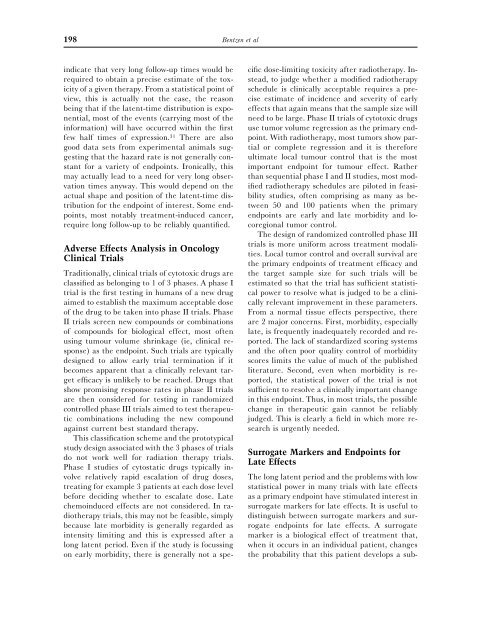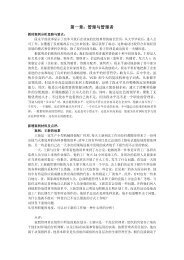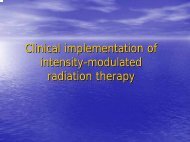Normal Tissue Effects: Reporting and Analysis
Normal Tissue Effects: Reporting and Analysis
Normal Tissue Effects: Reporting and Analysis
You also want an ePaper? Increase the reach of your titles
YUMPU automatically turns print PDFs into web optimized ePapers that Google loves.
198 Bentzen et al<br />
indicate that very long follow-up times would be<br />
required to obtain a precise estimate of the toxicity<br />
of a given therapy. From a statistical point of<br />
view, this is actually not the case, the reason<br />
being that if the latent-time distribution is exponential,<br />
most of the events (carrying most of the<br />
information) will have occurred within the first<br />
few half times of expression. 31 There are also<br />
good data sets from experimental animals suggesting<br />
that the hazard rate is not generally constant<br />
for a variety of endpoints. Ironically, this<br />
may actually lead to a need for very long observation<br />
times anyway. This would depend on the<br />
actual shape <strong>and</strong> position of the latent-time distribution<br />
for the endpoint of interest. Some endpoints,<br />
most notably treatment-induced cancer,<br />
require long follow-up to be reliably quantified.<br />
Adverse <strong>Effects</strong> <strong>Analysis</strong> in Oncology<br />
Clinical Trials<br />
Traditionally, clinical trials of cytotoxic drugs are<br />
classified as belonging to 1 of 3 phases. A phase I<br />
trial is the first testing in humans of a new drug<br />
aimed to establish the maximum acceptable dose<br />
of the drug to be taken into phase II trials. Phase<br />
II trials screen new compounds or combinations<br />
of compounds for biological effect, most often<br />
using tumour volume shrinkage (ie, clinical response)<br />
as the endpoint. Such trials are typically<br />
designed to allow early trial termination if it<br />
becomes apparent that a clinically relevant target<br />
efficacy is unlikely to be reached. Drugs that<br />
show promising response rates in phase II trials<br />
are then considered for testing in r<strong>and</strong>omized<br />
controlled phase III trials aimed to test therapeutic<br />
combinations including the new compound<br />
against current best st<strong>and</strong>ard therapy.<br />
This classification scheme <strong>and</strong> the prototypical<br />
study design associated with the 3 phases of trials<br />
do not work well for radiation therapy trials.<br />
Phase I studies of cytostatic drugs typically involve<br />
relatively rapid escalation of drug doses,<br />
treating for example 3 patients at each dose level<br />
before deciding whether to escalate dose. Late<br />
chemoinduced effects are not considered. In radiotherapy<br />
trials, this may not be feasible, simply<br />
because late morbidity is generally regarded as<br />
intensity limiting <strong>and</strong> this is expressed after a<br />
long latent period. Even if the study is focussing<br />
on early morbidity, there is generally not a specific<br />
dose-limiting toxicity after radiotherapy. Instead,<br />
to judge whether a modified radiotherapy<br />
schedule is clinically acceptable requires a precise<br />
estimate of incidence <strong>and</strong> severity of early<br />
effects that again means that the sample size will<br />
need to be large. Phase II trials of cytotoxic drugs<br />
use tumor volume regression as the primary endpoint.<br />
With radiotherapy, most tumors show partial<br />
or complete regression <strong>and</strong> it is therefore<br />
ultimate local tumour control that is the most<br />
important endpoint for tumour effect. Rather<br />
than sequential phase I <strong>and</strong> II studies, most modified<br />
radiotherapy schedules are piloted in feasibility<br />
studies, often comprising as many as between<br />
50 <strong>and</strong> 100 patients when the primary<br />
endpoints are early <strong>and</strong> late morbidity <strong>and</strong> locoregional<br />
tumor control.<br />
The design of r<strong>and</strong>omized controlled phase III<br />
trials is more uniform across treatment modalities.<br />
Local tumor control <strong>and</strong> overall survival are<br />
the primary endpoints of treatment efficacy <strong>and</strong><br />
the target sample size for such trials will be<br />
estimated so that the trial has sufficient statistical<br />
power to resolve what is judged to be a clinically<br />
relevant improvement in these parameters.<br />
From a normal tissue effects perspective, there<br />
are 2 major concerns. First, morbidity, especially<br />
late, is frequently inadequately recorded <strong>and</strong> reported.<br />
The lack of st<strong>and</strong>ardized scoring systems<br />
<strong>and</strong> the often poor quality control of morbidity<br />
scores limits the value of much of the published<br />
literature. Second, even when morbidity is reported,<br />
the statistical power of the trial is not<br />
sufficient to resolve a clinically important change<br />
in this endpoint. Thus, in most trials, the possible<br />
change in therapeutic gain cannot be reliably<br />
judged. This is clearly a field in which more research<br />
is urgently needed.<br />
Surrogate Markers <strong>and</strong> Endpoints for<br />
Late <strong>Effects</strong><br />
The long latent period <strong>and</strong> the problems with low<br />
statistical power in many trials with late effects<br />
as a primary endpoint have stimulated interest in<br />
surrogate markers for late effects. It is useful to<br />
distinguish between surrogate markers <strong>and</strong> surrogate<br />
endpoints for late effects. A surrogate<br />
marker is a biological effect of treatment that,<br />
when it occurs in an individual patient, changes<br />
the probability that this patient develops a sub-
















